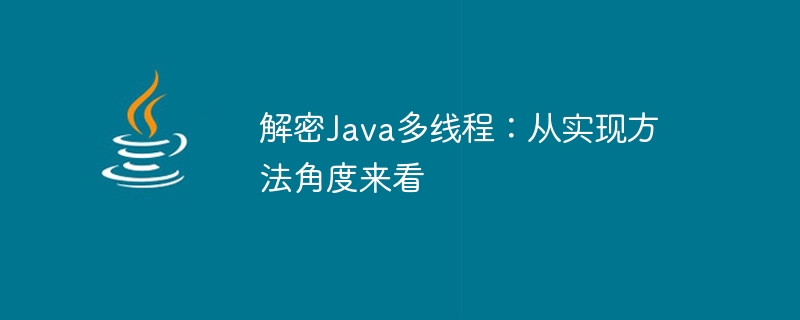

Decrypting Java multi-threading: from the perspective of implementation methods, specific code examples are needed
Introduction:
Multi-threading is an important concept in the field of computer science, It is also a part that cannot be ignored in Java programming. Java provides developers with convenient and flexible multi-threaded programming capabilities through its built-in threading mechanism. This article will decrypt Java multi-threading from the perspective of implementation methods, and explain the implementation principles and common techniques of multi-threading through specific code examples.
1. Basic concepts:
1.1 Thread:
Thread is the smallest unit that the operating system can perform operation scheduling. It is included in the process and is the actual operating unit in the process.
1.2 Multi-threading:
Multi-threading refers to a programming model in which a program contains multiple threads executing simultaneously.
2. Multi-threading implementation method:
In Java, there are two main ways to implement multi-threading: inheriting the Thread class and implementing the Runnable interface. These two methods will be introduced below and specific code examples will be given.
2.1 Inherit the Thread class:
In Java, multi-threading can be achieved by inheriting the Thread class. The specific steps are as follows:
(1) Define a subclass inherited from the Thread class, and rewrite the run() method of the subclass, which defines the tasks to be performed by the thread.
(2) Create a subclass object and start the thread by calling the start() method.
The sample code is as follows:
public class MyThread extends Thread { @Override public void run() { // 线程要执行的任务 for (int i = 0; i < 5; i++) { System.out.println("MyThread: " + i); } } } public class Main { public static void main(String[] args) { // 创建线程对象 MyThread myThread = new MyThread(); // 启动线程 myThread.start(); // 主线程继续执行 for (int i = 0; i < 5; i++) { System.out.println("Main Thread: " + i); } } }
Running the above code will output the execution results of the main thread and the sub-thread at the same time.
2.2 Implement the Runnable interface:
In addition to inheriting the Thread class, Java also provides a way to implement the Runnable interface to implement multi-threading. The specific steps are as follows:
(1) Define a class to implement the Runnable interface and implement the run() method in the interface.
(2) Create an object of the implementation class of the Runnable interface and pass it as a parameter to the constructor of the Thread class.
(3) Call the start() method of the Thread class to start the thread.
The sample code is as follows:
public class MyRunnable implements Runnable { @Override public void run() { // 线程要执行的任务 for (int i = 0; i < 5; i++) { System.out.println("MyRunnable: " + i); } } } public class Main { public static void main(String[] args) { // 创建Runnable接口的实现类对象 MyRunnable myRunnable = new MyRunnable(); // 创建线程对象,并传入Runnable接口的实现类对象 Thread thread = new Thread(myRunnable); // 启动线程 thread.start(); // 主线程继续执行 for (int i = 0; i < 5; i++) { System.out.println("Main Thread: " + i); } } }
Similarly, running the above code will output the execution results of the main thread and the sub-thread at the same time.
Summary:
This article decrypts Java multi-threading from the perspective of implementation methods by introducing the two methods of inheriting the Thread class and implementing the Runnable interface. From the code examples, we can see that multi-threaded programming is very simple in Java. You only need to rewrite the run() method and call the start() method. At the same time, we also learned that it is more common to use the Runnable interface to implement multi-threading in actual development, because it can avoid the limitations of single inheritance and can better achieve resource sharing.
By deeply understanding the implementation methods of multi-threading and mastering related programming skills, we can better use multi-threading to improve the performance and efficiency of the program and make the program have better concurrency. I believe that through the introduction of this article, readers can become more familiar with the implementation principles of Java multi-threading and lay a solid foundation for future multi-thread programming work.
The above is the detailed content of Revealing the methods of multi-threading implementation in Java. For more information, please follow other related articles on the PHP Chinese website!




